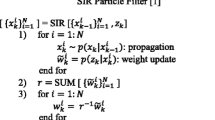Abstract
In this paper, a graphics processor unit (GPU) accelerated particle filtering algorithm is presented with an introduction to a novel resampling technique. The aim remains in the mitigation of particle impoverishment as well as computational burden, problems which are commonly associated with classical (systematic) resampled particle filtering. The proposed algorithm employs a priori-space dependent distribution in addition to the likelihood, and hence is christened as dual distribution dependent (D3) resampling method. Simulation results exhibit lesser values for root mean square error (RMSE) in comparison to that for systematic resampling. D3 resampling is shown to improve particle diversity after each iteration, thereby affecting the overall quality of estimation. However, computational burden is significantly increased owing to few excessive computations within the newly formulated resampling framework. With a view to obtaining parallel speedup we introduce a CUDA version of the proposed method for necessary acceleration by GPU. The GPU programming model is detailed in the context of this paper. Implementation issues are discussed along with illustration of empirical computational efficiency, as obtained by executing the CUDA code on Quadro 2000 GPU. The GPU enabled code has a speedup of 3 and 4 over the sequential executions of systematic and D3 resampling methods respectively. Performance both in terms of RMSE and running time have been elaborated with respect to different selections for threads per block towards effective implementations. It is in this context that, we further introduce a cost to performance metric (CPM) for assessing the algorithmic efficiency of the estimator, involving both quality of estimation and running time as comparative factors, transformed into a unified parameter for assessment. CPM values for estimators obtained from all such different choices for threads per block have been determined and a final value for the chosen parameter is resolved for generation of a holistic effective estimator.











Similar content being viewed by others
Explore related subjects
Discover the latest articles, news and stories from top researchers in related subjects.References
Gordon N, Salmond D (Apr. 1993) Novel approach to nonlinear/non-Gaussian Bayesian state estimation. IEE Proc F 140(2):107–113
Sanjeev Arulampalam M, Maskell Simon, Gordon Neil, Clapp Tim (2002) A tutorial on particle filters for online nonlinear/non-Gaussian Bayesian tracking. IEEE Trans Signal Proc 50:2
James V (2009) Candy, Bayesian signal processing classical, modern, and particle filtering methods. Wiley, New Jersey
Simon Dan (2006) Optimal state estimation Kalman H and nonlinear approaches. Wiley, New Jersey
Kak Marc (1964) Statistical independence in probability analysis and number theory, mathematical association of America. Wiley, New Jersey
Pitt M, Shephard N (1999) Filtering via simulation: auxiliary particle filter, Jasa, vol 94
Karlsson R, Gustafsson F (2003) Particle filter for underwater terrain navigation, Tech Rep LiTH-ISY-R-2530, Sweden
Musso C, Oudjane N, LeGland F (2001) Improving regularised particle filters, Sequential Monte Carlo methods in practice. In: Doucet A, de Freitas JFG, Gordon NJ (eds) Springer, New York
de Freitas N, Andrieu C, Hojen-Sorensen P, Niranjan M, Gee A (2001) Sequential Monte Carlo methods for neural networks, Sequential Monte Carlo methods in practice. In: Doucet A, de Freitas N, Gordon N (eds) Springer, New York, pp 359379
Fearnhead P (1998) Sequential Monte Carlo methods in filter theory, PhD thesis, University of Oxford, Oxford
Brun Olivier, Teuliere Vincent, Garcia Jean-Marie (2002) Parallel particle filtering. J Parallel Distrib Comput 62:1186–1202
Bolic Miodrag, Djuric Petar M, Hong Sangjin (2005) Resampling algorithms and architectures for distributed particle filters. IEEE Trans Signal Proc 53:7
Hong S, Djuric PM (2006) High-throughput scalable parallel resampling mechanism for effective redistribution. In: Proceedings of IEEE transactions on signal processing of particles, vol 54, no 3, 2006
Rosn O, Medvedev A, Ekman M (2010) Speedup and tracking accuracy evaluation of parallel particle filter algorithms implemented on a multicore architecture. In: Proceedings of IEEE international conference on control applications part of 2010 IEEE multi-conference on systems and Control, Japan, 8–10 September 2010
Rosn Olov, Medvedev Alexander (2013) Efficient parallel implementation of state estimation algorithms on multicore platforms. IEEE Trans Control Syst Technol 21:1
Chen Tianshi, Schn Thomas B, Ohlsson Henrik, Ljung Lennart (2011) Decentralized particle filter with arbitrary state decomposition. IEEE Trans Signal Proc 59:2
Hwang Kyuyeon, Sung Wonyong (2013) Load balanced resampling for real-time particle filtering on graphics processing units. IEEE Trans Signal Proc 61:2
Bolic M, Djuric PM, Hong S (2003) New resampling algorithms for particle filters. In: Proceedings of IEEE international conference on acoustics, speech, and signal processing, 2003, (ICASSP ’03)
Liu J (2001) Monte Carlo strategies in scientific computing. Springer, New York
Fossen TI (2002) Marine control systems. Marine Cybernetics AS, Norway, pp 19–38
Sanders J, Kandrot E (2011) CUDA by example. Addison-Wisley, USA
Cecilia JM, Garcia JM, Ujaldon M (2010) The GPU on the matrix-matrix multiply: performance study and contributions. Parallel computing: from multicores and GPUs to Petascale. doi:10.3233/978-1-60750-530-3-331, IOS Press
Amdahl GM (1967) Validity of the single processor approach to achieving large scale computing capabilities. AFIPS Conf Proc 30:483–485. doi:10.1145/1465482.1465560
Cuda C Programming Guide, NVIDIA Corporation, 2013, URL:http://docs.nvidia.com/cuda/pdf/CUDA C Programming Guide.pdf
Pequito S (2009) From particle filters to Malliavin filtering with application to target tracking, URL: http://users.isr.ist.utl.pt/pjcro/courses/def0910/docs/report_SP.pdf
Author information
Authors and Affiliations
Corresponding author
Rights and permissions
About this article
Cite this article
Das, S.K., Mazumdar, C. & Banerjee, K. GPU accelerated novel particle filtering method. Computing 96, 749–773 (2014). https://doi.org/10.1007/s00607-014-0400-2
Received:
Accepted:
Published:
Issue Date:
DOI: https://doi.org/10.1007/s00607-014-0400-2




